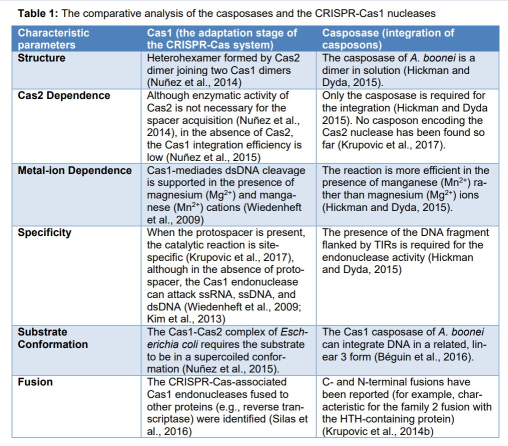Casposons – silent heroes of the CRISPR-Cas systems evolutionary history
DOI:
https://doi.org/10.17179/excli2022-5581Keywords:
casposons, Cas1, mobile genetics elements, CRISPR- CasAbstract
Many archaeal and bacterial organisms possess an adaptive immunity system known as CRISPR-Cas. Its role is to recognize and degrade foreign DNA showing high similarity to repeats within the CRISPR array. In recent years computational techniques have been used to identify cas1 genes that are not associated with CRISPR systems, named cas1-solo. Often, cas1-solo genes are present in a conserved neighborhood of PolB-like polymerase genes, which is a characteristic feature of self-synthesizing, eukaryotic transposons of the Polinton class. Nearly all cas1-polB genomic islands are flanked by terminal inverted repeats and direct repeats which correspond to target site duplications. Considering the patchy taxonomic distribution of the identified islands in archaeal and bacterial genomes, they were characterized as a new superfamily of mobile genetic elements and called casposons. Here, we review recent experiments on casposons' mobility and discuss their discovery, classification, and evolutionary relationship with the CRISPR-Cas systems.

Downloads
Published
How to Cite
License
Copyright (c) 2023 Paulina Smaruj, Marek Kieliszek

This work is licensed under a Creative Commons Attribution 4.0 International License.
Authors who publish in this journal agree to the following terms:
- The authors keep the copyright and grant the journal the right of first publication under the terms of the Creative Commons Attribution license, CC BY 4.0. This licencse permits unrestricted use, distribution and reproduction in any medium, provided that the original work is properly cited.
- The use of general descriptive names, trade names, trademarks, and so forth in this publication, even if not specifically identified, does not imply that these names are not protected by the relevant laws and regulations.
- Because the advice and information in this journal are believed to be true and accurate at the time of publication, neither the authors, the editors, nor the publisher accept any legal responsibility for any errors or omissions presented in the publication. The publisher makes no guarantee, express or implied, with respect to the material contained herein.
- The authors can enter into additional contracts for the non-exclusive distribution of the journal's published version by citing the initial publication in this journal (e.g. publishing in an institutional repository or in a book).





